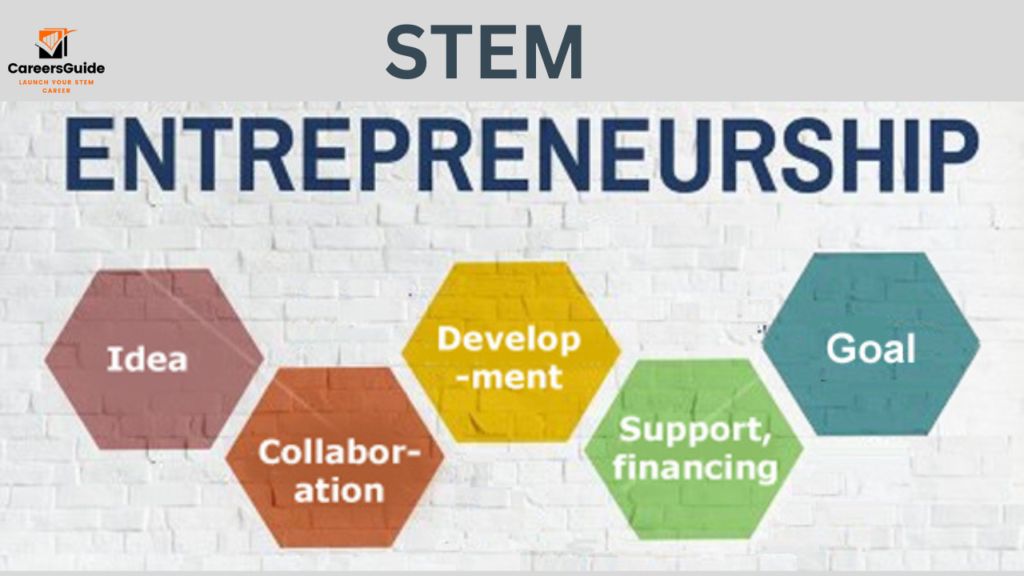Did you know that STEM entrepreneurs are driving innovation and contributing to economic growth at an unprecedented scale? The world of science, technology, engineering, and mathematics is brimming with entrepreneurial opportunities, offering a unique pathway for individuals to make a significant impact while pursuing their passion for these fields.

In this article, I will guide you through the exciting realm of STEM entrepreneurship, uncovering the vast potential and possibilities that exist within this dynamic industry. We will explore the entrepreneurial mindset, discuss the power of STEM careers, delve into the challenges faced by women in STEM entrepreneurship, and provide insights into starting, scaling, and sustaining a successful STEM business. Whether you are an aspiring STEM entrepreneur or simply interested in the intersection of science, technology, and business, this article will provide valuable knowledge and inspiration.
So let’s dive in and discover the multitude of opportunities awaiting those who are ready to take on the world of STEM entrepreneurship!
Key Takeaways:
- STEM entrepreneurship offers unique opportunities for individuals passionate about science, technology, engineering, and mathematics.
- An entrepreneurial mindset is crucial for success in the STEM industry.
- STEM careers provide a wide range of exciting and lucrative possibilities.
- Women in STEM face unique challenges in entrepreneurship, but strategies can be employed to overcome these barriers.
- Starting a STEM business requires careful planning and execution.
Understanding the Entrepreneurial Mindset
Before embarking on the journey of STEM entrepreneurship, it is crucial to comprehend the entrepreneurial mindset. This mindset encompasses a set of key traits and characteristics that pave the way for success in the dynamic world of science, technology, engineering, and mathematics.
Passion and Perseverance: Entrepreneurs in the STEM industry possess an unwavering passion for their field of expertise. They display a relentless drive to solve problems, innovate, and create meaningful solutions. It is this passion that fuels their motivation and pushes them to persevere through challenges and setbacks.
Risk-Taking and Adaptability: The ability to take calculated risks and adapt to changing circumstances is another hallmark of the entrepreneurial mindset. STEM entrepreneurs understand that breakthroughs often require stepping outside of their comfort zones and embracing uncertainty. They possess a willingness to learn from failures and swiftly pivot their strategies when needed.
Visionary Thinking: Successful STEM entrepreneurs possess a unique ability to identify untapped opportunities and envision a future that others may not yet see. They have the capacity to think creatively, dream big, and turn their visions into reality. This visionary thinking empowers them to disrupt industries, drive innovation, and make a lasting impact.
Continuous Learning: STEM entrepreneurs are lifelong learners, constantly seeking new knowledge, skills, and insights within their respective fields. They embrace a growth mindset and actively pursue personal and professional development. This commitment to continuous learning enables them to stay ahead of the curve and adapt to the ever-evolving landscape of STEM entrepreneurship.
Collaboration and Networking: STEM entrepreneurs understand the power of collaboration and recognize the value of building strong networks. They actively seek out like-minded individuals, mentors, and potential collaborators to exchange ideas, gain support, and form strategic partnerships. This collaborative mindset fosters innovation, expands opportunities, and propels their ventures forward.
Data-Driven Decision-Making: STEM entrepreneurship relies on data-driven decision-making. Successful entrepreneurs leverage a wealth of information, analytics, and insights to make informed choices and drive their businesses forward. They understand the importance of collecting and analyzing data to make strategic moves and maximize their chances of success.
Customer-Centricity: STEM entrepreneurs prioritize understanding and serving the needs of their customers. They are committed to delivering products and services that address pain points, solve problems, and enhance people’s lives. By staying attuned to customer feedback and preferences, they can iterate and improve their offerings to ensure long-term success.
The entrepreneurial mindset is the foundation upon which STEM entrepreneurs build their businesses. It empowers them to overcome challenges, seize opportunities, and create breakthrough innovations. By embracing these key traits and characteristics, aspiring STEM entrepreneurs can unlock their full potential and make a meaningful impact in their chosen industries.
The Power of STEM Careers

STEM careers offer a world of exciting possibilities and tremendous opportunities for growth and innovation. With a strong focus on science, technology, engineering, and mathematics, these fields are at the forefront of shaping our future. From solving complex global challenges to creating groundbreaking technologies, STEM professionals play a vital role in driving progress and making a positive impact on society.
Overcoming Challenges in STEM Entrepreneurship
Entrepreneurship in STEM fields can be a rewarding and fulfilling career path, but it is not without its challenges. Women in STEM, in particular, face unique obstacles and barriers in pursuing entrepreneurship. However, with the right strategies and support, these challenges can be overcome, and gender equality in STEM entrepreneurship can be promoted.
1. Breaking Through Stereotypes
“In STEM, women cannot succeed.”This is a persistent misconception in society that might deter women from pursuing STEM business endeavors. Breaking through these stereotypes requires debunking misconceptions and highlighting the achievements and success stories of women in STEM entrepreneurship. By challenging stereotypes and showcasing the diverse range of female talent in STEM, we can inspire more women to pursue their entrepreneurial ambitions.
2. Building Supportive Networks
Building a strong support network is crucial for women in STEM entrepreneurship. Surrounding oneself with mentors, peers, and allies who understand the unique challenges faced by women in the industry can provide invaluable guidance and encouragement. Networking events, mentorship programs, and professional organizations focused on women in STEM can offer opportunities to connect and collaborate with like-minded individuals.
3. Access to Funding and Resources
Securing funding and accessing necessary resources is often a major hurdle for entrepreneurs, especially for women in STEM. Overcoming this challenge requires actively seeking out funding opportunities and resources specifically designed to support women in STEM entrepreneurship. Government grants, angel investors, venture capital firms that prioritize diversity, and organizations that provide financial and mentorship support to women in STEM are all avenues that can be explored.
4. Addressing Work-Life Balance
Juggling the demands of entrepreneurship and personal responsibilities can be a significant challenge for women in STEM. Striking a healthy work-life balance is crucial for overall well-being and sustained success. Creating flexible work environments, implementing policies that support work-life integration, and fostering a culture that values work and personal life harmony are essential steps towards overcoming this challenge.
By addressing the unique challenges faced by women in the field, we can create a more diverse and inclusive entrepreneurial ecosystem in STEM.”
The journey of women in STEM entrepreneurship is filled with unique challenges, but by implementing the strategies mentioned above and promoting gender equality, we can foster an environment that empowers women to thrive as successful entrepreneurs in the STEM industry.
Navigating the Startup Journey
Starting a STEM business requires careful planning and execution. As an entrepreneur in the field of science, technology, engineering, and mathematics, you need to navigate through the essential steps of launching your STEM startup. From idea generation to funding and scaling, each phase plays a crucial role in the success of your venture. Let me guide you through the key aspects of this exciting journey.
Idea Generation
The first step in starting a STEM business is to generate innovative ideas. Identify a problem or a gap in the market that you are passionate about solving. Brainstorm potential solutions and assess their feasibility, scalability, and potential impact.To learn more about the requirements and preferences of your target market, conduct market research. By combining your expertise in STEM with market demand, you can create a compelling and unique value proposition.
Market Validation
Once you have a promising idea, it’s essential to validate its market potential. Conduct surveys, interviews, and focus groups to gather feedback from potential customers and industry experts.Evaluate market trends, the competitive environment, and any possible entrance obstacles. This validation process will help you refine your concept, identify opportunities for differentiation, and ensure that there is demand for your product or service.
Business Plan Development
With a validated idea, it’s time to develop a comprehensive business plan. Outline your mission, vision, and goals for the STEM startup. Establish your value proposition, target market, and revenue model. Create a detailed marketing strategy, sales projections, and financial forecasts. A well-structured business plan will not only serve as a roadmap for your startup but will also help you attract investors and secure funding.
Funding and Resources
Funding is often a critical challenge for STEM startups. Explore different funding options, such as bootstrapping, crowdfunding, angel investors, venture capital, or government grants. Prepare a compelling pitch deck and business plan to convince potential investors of the financial viability and growth potential of your venture. Additionally, leverage resources and support networks offered by business incubators, accelerators, and STEM-focused organizations.
Product Development and Prototyping
As you secure funding, focus on developing your minimum viable product (MVP) or prototype. Collaborate with engineers, designers, and other experts to bring your idea to life. Embrace an iterative approach, gathering feedback from early adopters and making necessary improvements. Test your product or service in real-world scenarios to ensure its functionality, reliability, and user experience.
Market Launch and Growth
When your product or service is ready, it’s time to launch and scale your STEM startup. Develop a compelling marketing and sales strategy to reach your target audience. Monitor market feedback and customer satisfaction to refine your offering. Continuously innovate and stay abreast of emerging technologies and industry trends. As your business grows, consider forming strategic partnerships, expanding your product line, or entering new markets to sustain long-term success.
By navigating the startup journey with purpose and perseverance, you can turn your STEM business idea into a thriving reality. Remember, each step is essential and requires careful planning, adaptability, and continuous learning. With the right mindset and strategic execution, you can embark on a rewarding path of entrepreneurial success in the STEM industry. Explore the hottest STEM career opportunities waiting for you!
Innovative STEM Startup Ideas
Are you looking for exciting STEM startup ideas that have the potential to revolutionize industries and create positive social impact? Look no further! In this section, I will present a range of innovative startup ideas in the fields of science, technology, engineering, and mathematics.
1. Smart Agriculture Solutions:
With the increasing demand for sustainable farming practices, there is a great opportunity to develop smart agriculture solutions. This could include technologies for precision farming, data analysis, and automation to optimize crop production and minimize resource waste.
2. Clean Energy Innovations:
As the world moves towards renewable energy sources, there is a need for innovations in clean energy generation, storage, and distribution. Startups can explore ideas such as solar power innovations, energy storage solutions, and smart grid technologies.
3. Healthcare Technologies:
The healthcare industry is ripe for technological disruption. Startups can focus on developing innovative healthcare technologies such as telemedicine platforms, wearable devices for remote patient monitoring, or AI-driven diagnostic tools.
4. Sustainable Materials:
With sustainability becoming a priority, there is a growing demand for eco-friendly materials. Startups can explore the development of novel materials that are biodegradable, recyclable, or have a reduced environmental impact.
5. EdTech Solutions:
With the increasing importance of digital education, there are opportunities for startups to develop STEM-focused educational technologies. This could include immersive learning platforms, virtual reality simulations, or personalized learning tools.
6. AI and Machine Learning Applications:
Artificial intelligence and machine learning hold immense potential. Startups can explore applications in various sectors, such as autonomous vehicles, predictive analytics, natural language processing, or intelligent automation.
Sustainability and innovation are at the core of these STEM startup ideas. By leveraging the latest technologies and addressing pressing global challenges, these startups have the potential to make a significant impact on society.
Stay tuned for more inspiring STEM startup ideas in the upcoming sections.
Startup Idea Description :
Smart Agriculture Solutions Technologies for precision farming, data analysis, and automation to optimize crop production and minimize resource wastage.
Clean Energy Innovations Development of clean energy generation, storage, and distribution technologies such as solar power innovations, energy storage solutions, and smart grid technologies.
Healthcare Technologies Development of innovative healthcare technologies such as telemedicine platforms, wearable devices for remote patient monitoring, or AI-driven diagnostic tools.
Sustainable Materials Exploration of novel materials that are biodegradable, recyclable, or have a reduced environmental impact.
EdTech Solutions Development of STEM-focused educational technologies such as immersive learning platforms, virtual reality simulations, or personalized learning tools.
AI and Machine Learning Applications Exploration of applications in various sectors, such as autonomous vehicles, predictive analytics, natural language processing, or intelligent automation.
Building a Strong STEM Network
A strong network is crucial for success in STEM entrepreneurship. By building connections within the STEM community, you can unlock valuable opportunities and pave the way for growth and collaboration. It is not enough to solely focus on your skills and expertise; cultivating relationships and leveraging the power of the collective are equally important in the entrepreneurial journey.

When it comes to building a network in STEM entrepreneurship, here are a few key strategies to consider:
- Attend industry events: Participating in conferences, workshops, and networking events tailored to STEM entrepreneurship allows you to meet like-minded individuals, potential collaborators, and mentors. These events provide a platform for sharing knowledge, exchanging ideas, and expanding your network. Take advantage of the opportunity to connect with industry leaders, investors, and experts who can offer guidance and support.
- Engage in online communities: Joining online communities, forums, and social media groups focused on STEM entrepreneurship can open doors to a vast network of individuals passionate about the same fields. These platforms offer spaces for asking questions, seeking advice, and sharing resources. Active participation in discussions and engaging with fellow entrepreneurs can help you establish meaningful connections and gain valuable insights.
- Seek out mentorship: Finding a mentor who has experience in STEM entrepreneurship can be invaluable. A mentor can provide guidance, share their wisdom, and offer support throughout your entrepreneurial journey. They can also introduce you to their network, expanding your connections and opening doors to new opportunities.
- Collaborate with academic institutions: Partnering with universities and research institutions can provide access to a wide range of resources, expertise, and talent. Collaborative projects and research initiatives foster networking opportunities, allowing you to connect with professors, students, and researchers who may be interested in pursuing entrepreneurial ventures.
Building a strong STEM network is not just about expanding your circle of connections; it’s about fostering meaningful and mutually beneficial relationships. Approach networking with a genuine interest in others, be open to collaboration, and invest time in nurturing these connections. Your network can serve as a support system, a source of inspiration, and a gateway to a myriad of STEM entrepreneurship opportunities.
“Your network is your net worth.” – Porter Gale”
- Benefits of Building a Strong STEM Network
- Access to industry insights and trends
- Opportunities for collaboration and partnerships
- Potential mentorship and guidance
- Introduction to investors and funding opportunities
- Exposure to diverse perspectives and ideas
- Supportive community for motivation and inspiration
Leveraging Technology in STEM Ventures
Technology revolutionizes the way we approach entrepreneurship in STEM fields. By harnessing the latest technological advancements, STEM ventures can drive innovation, accelerate growth, and seize new opportunities.
Exploring Stem Entrepreneurship
When exploring stem entrepreneurship, it’s crucial to stay abreast of the cutting-edge technologies that shape the industry. From artificial intelligence and machine learning to blockchain and the Internet of Things (IoT), these advancements offer transformative potential for STEM businesses.
One of the key benefits of leveraging technology in STEM ventures is the ability to automate processes, optimize operations, and enhance productivity. Automation solutions, data analytics software, and robotics technologies streamline workflows, enabling entrepreneurs to focus on high-value tasks and strategic decision-making.
STEM Entrepreneurship Opportunities
The integration of technology opens up new realms of possibility for STEM entrepreneurship. For example, 3D printing allows for rapid prototyping and manufacturing, reducing costs and time-to-market for innovative products. Augmented reality (AR) and virtual reality (VR) create immersive experiences that can revolutionize training, education, and simulation in various STEM industries.

Moreover, the rise of e-commerce and digital platforms provides STEM entrepreneurs with direct access to global markets. This enables them to reach a wider customer base, scale their operations, and drive revenue growth.
The Role of Technology in STEM Ventures
Technology serves as the backbone of many successful STEM ventures, providing the necessary tools and infrastructure for innovation and growth.The following are some important fields in which technology is essential:
“Technology enables us to pioneer groundbreaking solutions that address major societal challenges. It empowers us to create sustainable businesses that drive positive change in the world.”
Technology Application :
Artificial Intelligence (AI) Automating tasks, improves decision-making, and enables advanced data analysis in fields like healthcare, finance, and manufacturing.
The Internet of Things (IoT) Connecting devices and sensors to collect real-time data, optimize processes, and improve efficiency in industries such as agriculture, energy, and logistics.
Blockchain Enabling secure and transparent transactions, decentralized systems, and smart contracts that can revolutionize finance, supply chain management, and cybersecurity.
Big Data Analytics Extracting valuable insights from massive datasets, driving evidence-based decision-making and predictive modeling in areas like marketing, healthcare, and urban planning.
Explore the hottest STEM career opportunities waiting for you!
These technologies, among others, empower STEM entrepreneurs to disrupt established industries, create innovative solutions, and meet the evolving needs of customers and society.
Securing Funding for STEM Startups
Securing funding is a critical step in the journey of starting and scaling a STEM startup. Without adequate financial resources, even the most innovative ideas may struggle to take flight. In this section, we will explore different funding options available to aspiring STEM entrepreneurs and provide valuable tips for securing investment.
Understanding Funding Options
When it comes to funding a STEM startup, there are several avenues to explore. These options include:
- Bootstrapping: Funding the business using personal savings, credit cards, or loans.
- Angel Investors: Finding individual investors who provide financial backing in exchange for equity or convertible debt.
- Venture Capital: Seeking investment from venture capital firms in exchange for equity shares.
- Crowdfunding: Getting money from a lot of people by using internet platforms.
- Government Grants: Applying for grants specifically designed to support STEM entrepreneurship.
Tips for Securing Investment
Securing funding for your STEM startup requires careful planning and strategic execution.The following advice can help you improve your chances of getting funding:
- Prepare a solid business plan: A comprehensive business plan demonstrates your understanding of the market, your value proposition, and your financial projections.
- Build a strong network: Connections can open doors to potential investors.Participate in business events, become a member of associations for professionals, and establish connections with fellow entrepreneurs.
- Showcase your expertise: Highlight your background and experience in the STEM field to build credibility and instill confidence in potential investors.
- Develop a prototype: If applicable, having a working prototype can help investors visualize your product or service and understand its potential impact.
- Pitch effectively: Craft a compelling pitch deck that clearly communicates your value proposition, market opportunity, and growth strategy.
- Seek mentorship: Engage with experienced mentors who can provide guidance, connections, and valuable insights into the fundraising process.
By exploring different funding options and implementing these tips, you can increase your chances of securing the necessary capital to fuel the growth of your STEM startup.
Creating a Diverse and Inclusive STEM Startup Culture
Diversity and inclusion are essential elements for fostering innovation and success in STEM entrepreneurship. By embracing a diverse workforce and creating an inclusive startup culture, organizations can unlock the full potential of their teams and drive meaningful progress in the fields of science, technology, engineering, and mathematics.
So, what does it take to build a diverse and inclusive STEM startup culture?The following tactics may be useful:
Cultivate a Culture of Equality
Start by establishing a strong foundation of equality within your organization. This involves treating all employees, regardless of their gender, race, or background, with fairness and respect. It is important to create an environment where everyone feels valued and included, fostering a sense of belonging and encouraging diverse perspectives.
Promote Gender Diversity
One of the key areas where diversity is lacking in STEM entrepreneurship is gender representation. Encourage more women to pursue careers in STEM by providing mentorship programs, scholarships, and networking opportunities specifically tailored to support and empower women in the field. By actively promoting gender diversity, you can tap into a vast pool of talent and creativity that will drive innovation and growth in your startup.
Emphasize Inclusive Hiring Practices
When building your team, prioritize inclusive hiring practices that focus on merit rather than biases. Implement blind resume screenings to eliminate unconscious biases and ensure that candidates are assessed solely based on their qualifications and skills. Additionally, actively seek out diverse candidates by expanding your recruitment efforts to include underrepresented communities in STEM.
Foster Collaboration and Mentoring
Create opportunities for collaboration and mentoring within your startup. Encourage employees to work together on projects and create a culture of knowledge-sharing and support. Implement mentoring programs where experienced professionals can guide and empower aspiring STEM entrepreneurs, especially those from underrepresented groups.
Create Employee Resource Groups
Employee Resource Groups (ERGs) are voluntary, employee-led groups that bring together individuals with shared experiences or backgrounds. Establishing ERGs focused on diversity and inclusion can create a sense of community and support within your startup. These organizations can offer a forum for professional growth, networking, and the support of personnel from underrepresented groups.
“Inclusivity is not just a buzzword – it is the key to unlocking the true potential of your startup. By cultivating a diverse and inclusive culture, you foster creativity, drive innovation, and attract the top talent in STEM entrepreneurship.”
“Jane Williams, Founder and CEO of DiversityTech”
Adopting these strategies will not only create a more diverse and inclusive startup culture but also position your company as a leader in the industry. By embracing the unique perspectives and talents of individuals from all backgrounds, you can unlock new opportunities, spark innovation, and drive positive change in STEM entrepreneurship.
Benefits of a Diverse and Inclusive STEM Startup Culture
- Increased creativity and innovation through diverse perspectives Improved problem-solving and decision-making processes
- Enhanced employee morale and satisfaction Expanded market reach and customer base
- Attracted top talent from diverse backgrounds Increased productivity and team performance
- Strengthened reputation as an inclusive and socially responsible company Boosted financial performance and long-term sustainability
The Role of Mentorship in STEM Entrepreneurship
Mentorship plays a crucial role in the development of STEM entrepreneurs. Having a mentor who is experienced in the STEM industry can provide invaluable guidance, support, and insights that can help aspiring entrepreneurs navigate the challenges and complexities of starting and growing a STEM business.
Exploring STEM entrepreneurship requires not only technical knowledge and skills but also a strong entrepreneurial mindset. This mindset involves a combination of creativity, resilience, problem-solving abilities, and a willingness to take risks. While these attributes can be cultivated through personal experiences, having a mentor can expedite the development of these qualities and provide a real-world perspective on how to navigate the entrepreneurial journey.
A mentor can offer personalized advice tailored to an entrepreneur’s specific goals, strengths, and areas for growth. They can provide insights into the industry, introduce connections, and help entrepreneurs identify opportunities and overcome challenges. With their guidance, entrepreneurs can develop strategies for business development, market analysis, product innovation, and customer acquisition.
A mentor is not only a source of knowledge and wisdom but also a source of inspiration and motivation.
How to Find and Cultivate Meaningful Mentor Relationships
Finding a mentor in the STEM industry may seem challenging, but several strategies can help aspiring entrepreneurs connect with mentors who align with their goals and aspirations:
- Join industry-specific organizations and attend networking events to meet professionals in the field.
- Reach out to professors, researchers, or professionals in STEM fields who have experience in entrepreneurship.
- Utilize online platforms and communities dedicated to STEM entrepreneurship to connect with like-minded individuals.
- Participate in workshops, seminars, or conferences focused on STEM and entrepreneurship.
- Engage with startup incubators and accelerators that offer mentorship programs.
Once a mentorship relationship is established, cultivating it is essential to ensure its effectiveness and longevity. Here are some tips for nurturing fruitful mentor relationships:
- Clearly communicate your goals and expectations.
- Be open to feedback and constructive criticism.
- Proactively seek advice and guidance.
- Regularly update your mentor on progress, challenges, and achievements.
- Show gratitude and appreciation for their time and expertise.
By actively seeking mentorship and building meaningful relationships with experienced professionals in the STEM industry, aspiring entrepreneurs can gain a competitive edge and increase their chances of success in STEM entrepreneurship.
Scaling and Sustaining a STEM Business
Scaling and sustaining a STEM business requires careful planning, strategic decision-making, and a solid understanding of the market. As you navigate the challenges of growth and sustainability, here are some valuable insights and tips to help you succeed.
1. Identify Growth Opportunities
Continuously seek out new opportunities for growth and expansion within your STEM business. Analyze market trends, anticipate customer needs, and stay ahead of the competition. By identifying and capitalizing on these growth opportunities, you can accelerate the scaling process and solidify your position in the industry.
2. Develop Strategic Partnerships
Collaborating with strategic partners can significantly enhance your chances of success in scaling and sustaining your STEM business. Seek out partnerships with complementary businesses or industry experts who can provide valuable resources, knowledge, and networks. These strategic alliances can open doors to new markets, customer bases, and funding opportunities.
3. Invest in Technology
Embrace technological advancements and invest in the latest tools, software, and infrastructure to streamline your operations, boost efficiency, and drive growth. Automation, data analytics, and artificial intelligence are just a few examples of technologies that can revolutionize your STEM business and propel it to new heights.
4. Nurture Your Talented Team
Your team is the driving force behind your STEM business, so it’s crucial to nurture and retain top talent. Create a positive work culture, provide ongoing training and development opportunities, and offer competitive compensation and benefits packages. By investing in your team, you’ll foster loyalty, productivity, and innovation, essential for scaling and sustaining your business.
5. Diversify Your Revenue Streams
Reduce the risk of dependency on a single product or service by diversifying your revenue streams. Identify additional opportunities within your niche or explore new markets where your expertise can be applied. By diversifying, you can insulate your business from economic downturns and create a more stable foundation for long-term growth.
6. Continuous Market Research
Stay attuned to market trends, consumer preferences, and technological advancements through continuous market research. Regularly monitor and assess your competition, analyze customer feedback, and adapt your strategies accordingly. By staying agile and responsive to changing market conditions, you’ll be better equipped to scale and sustain your STEM business.
“Jane Smith, CEO of STEM Innovators”
As you scale and sustain your STEM business, keep in mind that it’s an ongoing process that requires continuous evaluation, adjustment, and innovation. By implementing these strategies and staying true to your entrepreneurial vision, you can navigate the challenges and unlock the full potential of your STEM venture.
Benefits of Scaling and Sustaining a STEM Business Challenges of Scaling and Sustaining a STEM Business :
1. Increased market share and revenue 1. Balancing growth with quality control
2. Improved brand reputation and recognition 2. Managing cash flow and financial stability
3. Access to new markets and customer bases 3. Scaling operations while maintaining efficiency
4. Attracting top talent and strategic partners 4. Adapting to changing market conditions
5. Creating long-term sustainability 5. Balancing innovation and risk management
Conclusion
In conclusion, exploring STEM entrepreneurship offers a world of opportunities for those passionate about science, technology, engineering, and mathematics. By cultivating an entrepreneurial mindset and harnessing the vast potential that exists in these fields, individuals can drive innovation, establish successful businesses, and create a lasting impact in the world of STEM.
The journey of STEM entrepreneurship begins with understanding the unique traits required for success in this realm. By prioritizing qualities such as resilience, adaptability, and a willingness to take calculated risks, aspiring entrepreneurs can navigate the challenges and seize the numerous opportunities that lie ahead.
From launching a STEM startup to securing funding, building a strong network, and embracing diversity and inclusion, the path to STEM entrepreneurship is as exciting as it is demanding. Leveraging the power of technology, seeking mentorship, and being open to learning from failure are essential components of this journey.
By exploring STEM entrepreneurship, individuals can not only shape their own future but also contribute to solving complex global challenges and making a positive difference in the world.
FAQ
What is STEM entrepreneurship?
STEM entrepreneurship refers to starting and running a business in the fields of science, technology, engineering, and mathematics. It involves leveraging knowledge and expertise in these areas to create innovative products, services, or solutions.
What are some STEM entrepreneurship opportunities?
There are numerous STEM entrepreneurship opportunities, including developing software applications, creating medical devices, designing renewable energy solutions, providing cybersecurity services, and much more. The possibilities are vast and continually expanding as technology advances.
What traits and characteristics are important for an entrepreneurial mindset?
The entrepreneurial mindset involves being proactive, resilient, and adaptable. It also requires problem-solving skills, a willingness to take calculated risks, the ability to think creatively, and a strong drive for success.
Why are STEM careers considered powerful?
STEM careers are considered powerful because they have a significant impact on society and offer abundant opportunities for growth and innovation. They are the driving force behind technological advancements, scientific discoveries, and improvements in various industries.
What challenges do women face in STEM entrepreneurship?
Women in STEM entrepreneurship face challenges such as gender bias, limited access to funding and resources, and a lack of representation and support networks. Overcoming these challenges requires addressing systemic barriers and promoting inclusivity and equality.
What are the essential steps for starting a STEM business?
The essential steps for starting a STEM business include identifying a market need, conducting market research, developing a business plan, securing funding, building a team, and launching and marketing the product or service.
Can you provide some innovative STEM startup ideas?
Sure! Innovative STEM startup ideas could include developing virtual reality educational platforms, creating AI-powered healthcare diagnostics, designing sustainable packaging solutions, building renewable energy storage systems, or developing smart home automation technologies.
Why is building a strong STEM network important?
Building a strong STEM network is important because it enables entrepreneurs to connect with like-minded individuals, share knowledge and resources, access opportunities for collaboration and partnerships, and stay updated on industry trends and advancements.



